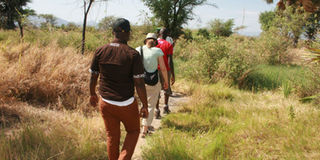The walk of nature at Kidepo valley park

Tourists on a nature trail in Kidepo Valley National Park. PHOTOs BY David Mafabi.
What you need to know:
Nature at its best. With a variety of birds unique only to the park, and a number of wild animals, among other things to watch, Kidepo Valley National Park is a great place for a nature walk experience
The virtues of walking in untamed environments and having exposure to nature, according to psychologists, reduces stress and boosts wellbeing.
A group of researchers/ psychologists from Stanford University found out that wild environments boost well-being by reducing obsessive, negative thoughts.
The study published last week in the Proceedings of the National Academy of Sciences, the Stanford scientists examined whether a nature walk could reduce rumination in 38 mentally healthy people.
They picked city dwellers because, the researchers predicted, they would have “a somewhat elevated level of rumination resulting from the ongoing and chronic stressors associated with the urban experience”.
Experiencing nature in itself is a wonderful activity but you can take it to another level by turning it into an active experience through taking a nature walk.
And if you are looking to get a feel of nature, but you don’t want to get so far from the touch of animals, go for a nature walk at Kidepo Valley National Park.
The park is good for short walks of about 15Km to help you enjoy the vast shrub land. You will not only walk but also view animals in distant shrubs using microscopes placed in designated places around the park.
“Many journalists love coming here to relax, watch the sun set as well as some of the bird species not found anywhere else in Africa,” Phillip Akoronymoe, a tour guide, said.
A visitor at Kidepo could also wander along the splendid Kidepo Valley river banks and see the attractive Borassus palm forest. One could also meet the Ik tribe during the pre-arranged hikes to Morungole Hills.
Akoronymoe says the main reason for nature walks is to capture the imagination and creativity of tourists by giving them a particular pursuit.
“Tourists end up creating some kind of collection of whatever interests them. They get to make their own guide, booklet, or collection from their discoveries,” said Akoronymoe.
Spectacular landscapes and great buffalo herds, with sprawling savanna and soaring mountains, also make Kidepo the most picturesque park in Africa.
Akoronymoe says Kidepo Valley has a very impressive bird list of more than 470 species, the second-highest population of any Ugandan reserve after Queen Elizabeth National Park.
“And the only way you can watch birds is to go for a nature walk. Although there are 56 species recorded, Kidepo is especially good for Spotting Raptors. Migratory birds are also present from November to April every year,” Akoronymoe said.
Stephen Nyadru, the tourism warden at Kidepo National Park, says the nature walk is like an exploration because it offers the best as far as bird watching trips are concerned.
“This park actually supports some of the rarest species in Uganda, such as Black-breasted Barbet and Karamoja Apalis,” said Nyadru.
He added that the southern Narus Valley is especially a great spot for one to start their nature walk and birding experience.
“One will see the attractive silver bird and small bands of Yellow-billed Shrike, frequent the thorn trees in the wilderness as you see a number of other widespread species such as the Vinaceous Dove, Hoopoe, Nubian Woodpecker, Mosque Swallow, the Ruppell’s and Superb Starlings, Scarlet-chested Sunbird, Little Weaver and Red-cheeked Cordon-bleu,” Nyadru said.
He added that as you move towards Katurum Valley facing Narus you will see the Klippa springer, commonly known as Asunu in the local language, White painted sooty, Stone partridge, Boron cistcolk, Clapperton francolin [Endemic] birds found only in Kidepo Valley National Park.
The conservation area manager, Johnson Masereka, says at every rock area, they have a small permanent water hole, which attracts a variety of seedeaters including the Yellow-rumped Seedeater and is visited at night by the Four-banded Sand grouse.
“Elephants, Buffaloes, and occasionally lions, Clapperton’s Francolin, Black Coucal, African Moustached and the Broad-tailed Warblers, Marsh Tchagra and Crimson-rumped Waxbill may be seen in the rank grass along the normally dry stream bed adjacent to the camp or along the nature trail,” said Masereka.
Other things to watch
Insects and entymology. Tourists are advised to bring along a magnifying glass, a variety of small vials or containers for collecting samples and a pack or box to hold everything in.
Rocks and minerals.Akoronymoe says the ultimate goal is to collect small pieces of a variety of minerals and rocks.
Micro-biology. During the nature walk, you will also explore tide pools, streams, ponds or other water systems like marshes.
Animal watching. Tourists will be amazed by the variety of creatures they will discover such as squirrels, pigeons, mice and chipmunks.
Eco-system nature walks. The nature walk can focus on eco-systems such as tide pools, forests, woods, ponds, rivers, streams, oceans, prairies, or just about any other type of eco-system or sub-system.




